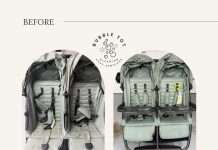I want to tell you about the pediatrician that cost me $3,000, my toddler son’s tooth extraction and the breastmilk that kept him healthy throughout the ordeal. But my story really begins when we introduced solid foods to my son and noticed a strange yellow line forming across his front teeth.
The Warning Signs
It all started when my son began eating solid food. I used the Weston A. Price approach to introducing solid foods and tried baby led weaning, but my son would often gag and spit out his food. I stayed firm on the approach but noticed a little yellow line appearing on his two front teeth sometime before he turned one. So I took a washcloth to it, as suggested by the pediatrician, and tried scraping it off. But the yellow line remained.
I thought little of it at first. I hadn’t introduced carbs or sugar into his diet yet so it couldn’t be a cavity, and I brushed his teeth regularly. I figured he got my less than stellar dental genes.
Fast forward to my 18-month-old son, feeding him solids hit an all-time low. I felt like a horrible mother. I had NO idea what my son liked because he spit out everything he ate. When I say everything, it was pretty much EVERYTHING, expect hummus and dumplings. He constantly choked on food and even gagged from the water he drank from a sippy cup. His front teeth now had a thick yellow line despite me providing him with a healthy diet.
Getting my son to eat became so bad that I dreaded feeding him. Any meal or snack became the most stressful part of my day, and, looking back, probably his too. Since my son was so healthy and active, it didn’t appear to be an issue to anyone else observing him, professional or otherwise. Everyone said, “It’s a toddler thing to eat that way.”
I listened and tried hard to remind myself that this is just the way my son is, and he will develop on his own accord, but I also seriously considered getting him evaluated for a sensory disorder — he couldn’t eat anything other than a few semi-mushy foods in tiny amounts.
I had done lots of research online over the past year, but something still wasn’t making sense, so I decided to take one more look at the reasoning behind the yellowing of my son’s teeth. (I have to say, I kind of envied those beautiful white teeth all of the other kids had and just couldn’t understand why my son’s teeth weren’t the same). So, I went online promising myself it would be my last Google search and through some divine grace, I found the answer!
 The Diagnosis
The Diagnosis
My son had the classic symptoms of tongue tie. Yellowing of the front two teeth, pulled in bottom front two teeth, chocking on water, spitting out food, not putting anything in his mouth as a baby, etc.
Once I found this out I immediately joined tongue tie Facebook groups, like Tongue Tie kids, and began calling preferred providers that specialize in what they call a release. After a little research and talking to other members we were finally scheduled to see the dentist. I was SOO excited because I was told the dentist would do the procedure on the spot if they found a tongue tie, and I felt hopeful that all the eating issues would be behind us.
The dentist determined that my son was both lip- and tongue-tied, but because he was so strong the dentist would need to sedate him to do the dental work. The earliest appointment they had was in four weeks! This more complicated procedure totaled up to about $3,000 out of pocket because our insurance didn’t cover it. We felt it had to be done, so we took money from our savings and proceeded forward. It was the longest four weeks of our lives.
The Procedure
Finally, the day arrived. We were very prepared; I even talked with my son leading up to the procedure about everything that would take place. The dentist and staff were amazing, and I felt confident and comfortable with their skills and professionalism. Unfortunately, due to decay on one of his teeth (a common side effect of tongue tie) he needed either a baby root canal or an extraction. He was a champ and did great. Little did I know, the easiest part was over and the hardest part was yet to come.
[easy-image-collage id=14571]
Post-Op Exercises
Doing exercises to make sure the tongue and lip don’t reattach was the most heart-wrenching thing I have ever done in my life, made worse because I had to do it to the one I love the most, my son. Basically, I had to stick my finger in his mouth and rub the lasered off part three times a day. It was very painful for him, and I felt horrible every time I did it, but I persevered as much as humanly possible. Luckily, his tongue and lip stayed detached because my commitment to the exercises for a full two weeks was subpar. Just thinking back to his painful cry brings up my own emotional trauma. Hopefully, he won’t remember it when he’s older.
Post Release
His improvement in the weeks following the surgery was nothing spectacular, but slowly, we noticed progress. His jaw actually started moving to chew, which I realized I’d never seen before. He stopped choking on water and stopped spitting out 80-90% of his food, but his food intake was still very limited. At times, I wasn’t sure we had done the right thing, but based on some advice from other tongue tie mamas I knew it could take time to see significant improvement.
After about one month I really began to notice changes. For instance, he ate an apple! Yes, an apple, and he didn’t spit out a piece (mama happily tearing up with joy on the inside)! He ate salad, and broccoli, and more, and he didn’t spit out anything! Prior to the release, he couldn’t eat any of these things and would definitely spit them out if he tried.
The biggest change was his smile. He actually has a huge smile now thanks to the release procedure because one of my friends said, “Wow, Eli! I have NEVER seen you smile so big before!” That was music to my ears because it was true. My son didn’t just have a stoic personality like we thought; he couldn’t smile for two years.
[easy-image-collage id=14553]
The Pediatrician & Breastmilk
So how is it that the pediatrician cost me $3,000 and lots of trauma? Well, when my son was just a few months old, a craniosacral therapist and nurse suggested we get him checked for tongue tie. So we did, and the pediatrician said, “He’s gaining weight, breastfeeding fine, and looks like a million bucks. Most of the time these things will resolve on their own.” Enter new parent response, “Okay.”
I now know, he didn’t even do the proper test for tongue tie, which is to look under the tongue and above the lip. I now know that most pediatricians are not trained in tongue tie diagnosis and therefore, do not know how to properly diagnose it. I now know that lactation consultants are the best at identifying tongue and lip tie and doing release exercises before age one is WAY easier and less traumatizing than when children are older. Now I know, which is why I share my story.
Luckily, my breastmilk kept him healthy through all of this; I was able to breastfeed my son on demand since the day he was born and happily he wanted to continue breastfeeding into toddlerhood. Without breastmilk, I am not certain he would have been able to maintain his weight and health.
And Now
Today, my two-year-old seems like your everyday toddler. He eats chips, broccoli, apples, carrots, pizza, ice cream, and even tries new foods with us, all without spitting them out — unless, of course, he doesn’t like them. He’s still a toddler, after all.
He still loves his hummus and dumplings, but his diet has expanded, and I don’t stress as much about feeding him. I guess after the procedure he just needed time to feel confident that his tongue was capable of eating all types of food. Oh, and his speech is exploding! He has SO much to tell us, and I love hearing all about it.
Tongue Tie Information
After my son was diagnosed with and treated for tongue and lip tie, I learned a lot about the tongue and all of the important functions it serves in the mouth.
The tongue is one of the strongest muscles in the body and is responsible for sending food to the back of the mouth to further the chewing process.
The tongue is also used to sweep salvia around your mouth. This action actually coats your teeth and helps prevents cavities between brushing.
If the tongue is tight, it can cause a tight neck and shoulders due to the pulling of the frenulum (the line of tissue that connects the underside of your tongue to the bottom of your mouth). Having your neck stretched backward with the spine arched in a ‘C’ shape can actually help loosen this. Prior to my son’s release procedure, this position showed in his sleeping posture.
Tongue tie is not diagnosed by just sticking out the tongue or raising it up. Rather, it has to do with the frenulum and its attachment at the bottom of your mouth. Interesting fact, in the past, midwives would keep one nail long to release any tongue tied babies.
Tongue tie can create speech impediments making it difficult to speak, which is how the expression “He’s tongue-tied” got started.
What I Learned
Trust your gut. Ask around, do your research, and don’t be afraid to get a second opinion.






















Hi! I may have found what is causing my toddler 4 front teeth this yellow line. We brush her teeth, do not give her fruit juice to drink, pay attention to her diet yet… the 4 front teeth look rough, and have this yellow line. She has a lip tie as well…. I would like to ask you more questions on your story. Is it possible?
Of course ?
My daughter also has the yellow line…what happens if i do nothing?? Does it resolve on it’s own? I think she was lip tied but the dentist suggested leaving it and wasn’t worried about the discoloration…nor did he make the connection. Did his teeth discoloration improve? Or will it improve with the adult teeth?